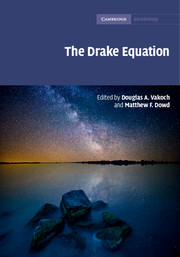Book contents
- The Drake EquationEstimating the Prevalence of Extraterrestrial Life through the Ages
- Cambridge Astrobiology
- The Drake Equation
- Copyright page
- Dedication
- Contents
- Contributors
- Foreword
- Preface
- Book part
- Introduction
- 1 Rate of formation of stars suitable for the development of intelligent life, R*, pre-1961
- 2 Rate of formation of stars suitable for the development of intelligent life, R*, 1961 to the present
- 3 Fraction of stars with planetary systems, fp, pre-1961
- 4 Fraction of stars with planetary systems, fp, 1961 to the present
- 5 Number of planets, per solar system, with an environment suitable for life, ne, pre-1961
- 6 Number of planets, per solar system, with an environment suitable for life, ne, 1961 to the present
- 7 Fraction of suitable planets on which life actually appears, fl, pre-1961
- 8 Fraction of suitable planets on which life actually appears, fl, 1961 to the present
- 9 Fraction of life-bearing planets on which intelligent life emerges, fi, pre-1961
- 10 Fraction of life-bearing planets on which intelligent life emerges, fi, 1961 to the present
- 11 Fraction of civilizations that develop a technology that releases detectable signs of their existence into space, fc, pre-1961
- 12 Fraction of civilizations that develop a technology that releases detectable signs of their existence into space, fc, 1961 to the present
- 13 Length of time such civilizations release detectable signals into space, L, pre-1961
- 14 Length of time such civilizations release detectable signals into space, L, 1961 to the present
- Afterword
- Index
- References
9 - Fraction of life-bearing planets on which intelligent life emerges, fi, pre-1961
Published online by Cambridge University Press: 05 July 2015
- The Drake EquationEstimating the Prevalence of Extraterrestrial Life through the Ages
- Cambridge Astrobiology
- The Drake Equation
- Copyright page
- Dedication
- Contents
- Contributors
- Foreword
- Preface
- Book part
- Introduction
- 1 Rate of formation of stars suitable for the development of intelligent life, R*, pre-1961
- 2 Rate of formation of stars suitable for the development of intelligent life, R*, 1961 to the present
- 3 Fraction of stars with planetary systems, fp, pre-1961
- 4 Fraction of stars with planetary systems, fp, 1961 to the present
- 5 Number of planets, per solar system, with an environment suitable for life, ne, pre-1961
- 6 Number of planets, per solar system, with an environment suitable for life, ne, 1961 to the present
- 7 Fraction of suitable planets on which life actually appears, fl, pre-1961
- 8 Fraction of suitable planets on which life actually appears, fl, 1961 to the present
- 9 Fraction of life-bearing planets on which intelligent life emerges, fi, pre-1961
- 10 Fraction of life-bearing planets on which intelligent life emerges, fi, 1961 to the present
- 11 Fraction of civilizations that develop a technology that releases detectable signs of their existence into space, fc, pre-1961
- 12 Fraction of civilizations that develop a technology that releases detectable signs of their existence into space, fc, 1961 to the present
- 13 Length of time such civilizations release detectable signals into space, L, pre-1961
- 14 Length of time such civilizations release detectable signals into space, L, 1961 to the present
- Afterword
- Index
- References
Summary
Among ancient authors, only the Epicureans believed in the existence of extraterrestrial intelligent beings (ETI). Astronomy was shaken at its roots after 1543, when Nicholas Copernicus presented his heliocentric system. By the end of the sixteenth century, Giordano Bruno speculated that stars are inhabited suns surrounded by inhabited planets. By 1750, growing acceptance of (1) the principle of plenitude (the idea that God or nature would populate most regions of the universe) and (2) versions of the so-called Copernican principle (the claim that all regions of space must be more or less identical to the region in our solar system) led to widespread belief in a large value for fi. An influential advocate for a high value of fi was Christiaan Huygens, who in his Cosmotheoros (1698) relied heavily on the latter principle. Belief in ETI was widespread in the eighteenth century, including such pioneers of stellar astronomy as Johann Lambert, Immanuel Kant, and William Herschel. Belief in ETI remained widespread from 1750 to 1870, despite counterevidence from such scientific laws as the inverse-square laws for gravitation, light, and radiant heat.
The first modern author who seriously challenged claims for a high value for fi was William Whewell, who in 1853 questioned whether higher forms of life could survive elsewhere in our solar system, doing this partly in terms of the inverse-square laws. Whewell's Of the Plurality of Worlds: An Essay outraged many of his contemporaries but gradually found limited acceptance among such astronomers as Richard Proctor, who recognized the need for a much lower value for fi. Roughly simultaneously, the Darwin-Wallace theory of evolution by natural selection led scientists to a deeper and more naturalistic understanding of the development of higher forms of life. Moreover, Wallace in 1904 stressed the improbability of beings as complex as humans developing elsewhere.
During the first half of the twentieth century, belief in ETI was at a relatively low level, partly because various scientific factors, such as encounter theories of planet formation, were taken seriously. Around 1950, belief in ETI became more widespread after the Miller-Urey experiment (1953) and the development of radio telescopes raised hopes that ETI might be contacted.1
- Type
- Chapter
- Information
- The Drake EquationEstimating the Prevalence of Extraterrestrial Life through the Ages, pp. 163 - 180Publisher: Cambridge University PressPrint publication year: 2015

